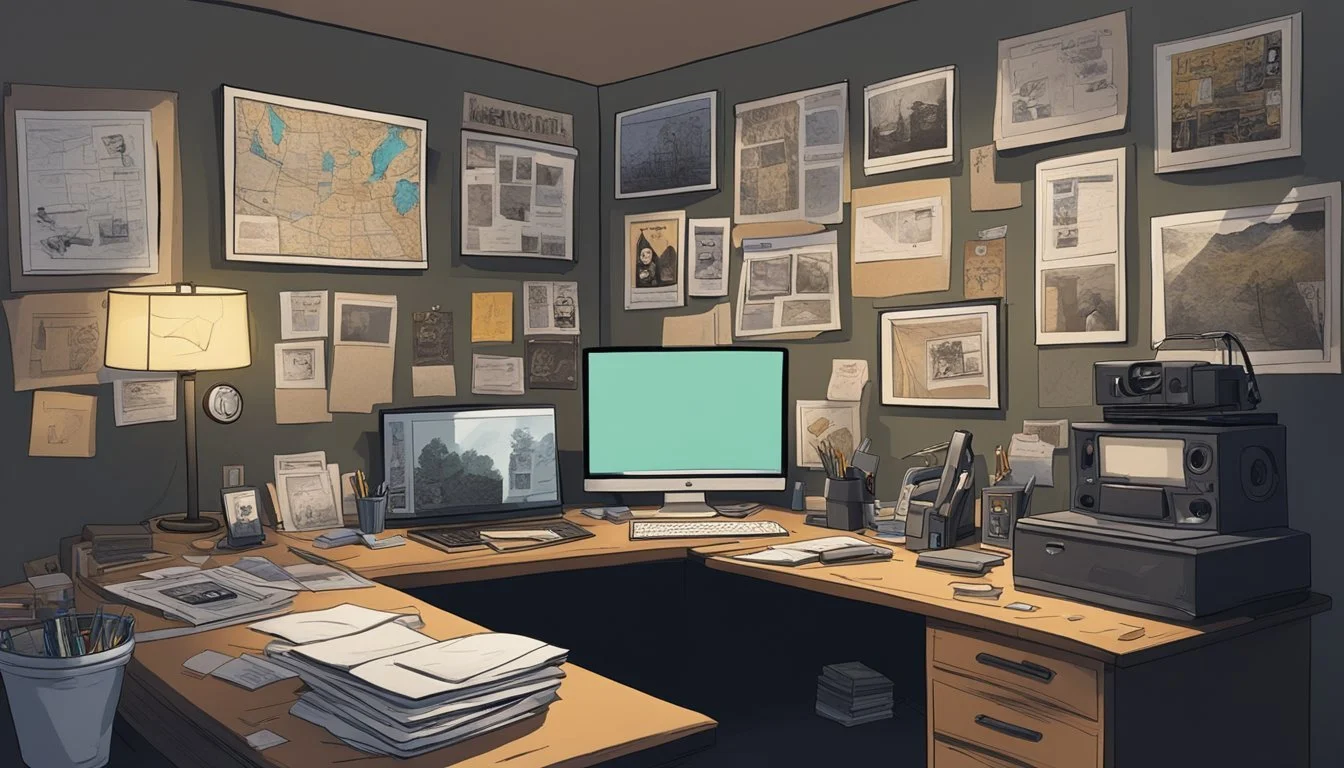10 Shocking True Crime Docs That Will Keep You Up at Night
True crime documentaries have captivated audiences for decades, offering a gripping look into real-life criminal cases. These films and series blend investigative journalism with compelling storytelling, delving into the depths of human behavior and the complexities of the justice system. True crime documentaries provide viewers with an opportunity to examine evidence, hear from key players, and form their own conclusions about notorious cases.
The genre has exploded in popularity in recent years, with streaming platforms and cable networks producing a steady stream of new content. From cold cases to high-profile trials, these documentaries cover a wide range of criminal acts and their aftermath. They often shed light on miscarriages of justice, societal issues, and the lasting impact of crimes on victims, families, and communities.
While some critics argue that true crime documentaries can be exploitative, many serve an important purpose by raising awareness, challenging assumptions, and even helping to solve cases. The best examples in the genre combine thorough research, ethical reporting, and cinematic craftsmanship to create thought-provoking and immersive viewing experiences.
Evolution of True Crime Documentaries
True crime documentaries have transformed from niche productions to mainstream phenomena, driven by technological advances and changing audience preferences. This shift has reshaped how real-life crimes are presented and consumed in media.
Origins and Historical Context
True crime documentaries emerged in the mid-20th century as an offshoot of investigative journalism. Early examples like "The Thin Blue Line" (1988) set the foundation for the genre. These films often focused on unsolved cases or controversial verdicts.
They aimed to shed new light on criminal investigations through in-depth research and interviews. The format gradually evolved, incorporating reenactments and archival footage to create more engaging narratives.
The Rise of Docuseries in Popular Culture
The 2010s saw true crime docuseries gain widespread popularity. Shows like "Making a Murderer" and "The Jinx" captivated audiences with their multi-episode formats. This structure allowed for deeper exploration of complex cases.
Docuseries offered viewers the chance to engage with stories over extended periods. They often presented new evidence or perspectives on well-known crimes. The serialized format also encouraged audience speculation and discussion between episodes.
Impact of Streaming Platforms on Accessibility
Streaming platforms like Netflix, Hulu, and HBO Max revolutionized true crime content distribution. They made documentaries and docuseries easily accessible to wide audiences. This availability fueled the genre's popularity and led to increased production.
Platforms invested heavily in original true crime content. Shows like "I'll Be Gone in the Dark" on HBO and "The Act" on Hulu garnered critical acclaim. The competition among streaming services resulted in higher production values and more diverse storytelling approaches.
Streaming also allowed for binge-watching, changing how audiences consume true crime content. This shift influenced the structure and pacing of many docuseries, designed to keep viewers engaged across multiple episodes.
Notable True Crime Documentaries
True crime documentaries have captivated audiences with their in-depth examinations of real-life criminal cases. These works provide insights into investigations, legal proceedings, and the human stories behind shocking events.
Groundbreaking Classics and Their Influence
"The Staircase" set a new standard for true crime documentaries when it premiered in 2004. The series followed the trial of Michael Peterson, accused of murdering his wife. Its unprecedented access and detailed exploration of the case influenced future productions.
"Making a Murderer" became a cultural phenomenon in 2015. The Netflix series examined the convictions of Steven Avery and Brendan Dassey, sparking public debates about the justice system. It demonstrated the power of streaming platforms to reach wide audiences with complex, long-form storytelling.
"The Keepers" delved into the unsolved murder of a nun in Baltimore, uncovering a web of secrets and alleged cover-ups. The 2017 series showcased how documentaries could reignite interest in cold cases and empower survivors to speak out.
Contemporary Hits and Viewer Reception
"Tiger King" became an unexpected hit in 2020, drawing millions of viewers with its eccentric characters and bizarre twists. The series explored the world of big cat owners, focusing on the feud between Joe Exotic and Carole Baskin.
"Mommy Dead and Dearest" shocked audiences in 2017 with its exploration of Munchausen syndrome by proxy. The HBO documentary examined the murder of Dee Dee Blanchard by her daughter Gypsy Rose, revealing a complex story of abuse and deception.
"American Murder: The Family Next Door" utilized social media posts and personal videos to create an intimate portrait of the Watts family murders. Released in 2020, it showcased how modern technology can be used to construct compelling narratives.
Critical Acclaim Versus Public Opinion
Critics often praise documentaries for their investigative depth and storytelling techniques. "The Staircase" and "Making a Murderer" received accolades for their comprehensive coverage and ability to raise questions about the legal system.
Public reception can differ from critical opinions. "Tiger King" faced criticism for its sensationalism, yet became a pop culture phenomenon. Viewers debated its ethics and treatment of subjects, highlighting the complex relationship between entertainment and journalism in true crime.
Some documentaries spark real-world change. "Making a Murderer" led to renewed legal efforts for its subjects. This impact has fueled discussions about the responsibility of filmmakers and the power of documentaries to shape public opinion on criminal cases.
Themes and Topics Explored
True crime documentaries delve into complex issues surrounding justice, victimization, and societal failures. They shine a spotlight on flaws in legal systems and the lasting impacts of criminal acts.
Investigating Miscarriages of Justice
Wrongful convictions feature prominently in many true crime documentaries. These films examine cases like The Central Park Five, where innocent individuals faced unjust imprisonment. Filmmakers scrutinize flawed evidence, coerced confessions, and prosecutorial misconduct.
Documentaries often reveal systemic biases in law enforcement and courts. They highlight how race, class, and public pressure can influence investigations and trials. Through interviews and archival footage, these works demonstrate how lives are devastated by wrongful convictions.
Some films follow exoneration efforts, showcasing the work of advocacy groups and legal teams. They illustrate the challenges of overturning convictions and the struggle for compensation after release.
Exposing Systems of Abuse and Manipulation
True crime documentaries frequently uncover patterns of abuse within institutions. They expose how powerful individuals or organizations exploit vulnerable populations. Films may focus on religious groups, educational institutions, or government agencies.
Sexual violence and child abuse are recurring themes. Documentaries reveal how predators operate and the failures of protective systems. They often feature survivor testimonies, shedding light on long-term trauma effects.
These works also examine psychological manipulation tactics used by abusers. They explore how cults, domestic abusers, and other bad actors control their victims. Experts provide insights into manipulation strategies and their impact on victims' decision-making.
Portraying Victims' Perspectives
Many documentaries prioritize victims' voices, countering sensationalized portrayals of crimes. They humanize those affected by violence, sharing personal stories and family impacts. Filmmakers often collaborate with victims' families to ensure respectful representation.
These works explore the long-term effects of trauma on survivors and communities. They may document victims' journeys toward healing and advocacy. Some films focus on unsolved cases, aiming to generate new leads and public interest.
Documentaries also address how media coverage affects victims. They critique sensationalized reporting and its consequences for those involved in high-profile cases.
The Art of Storytelling in Crime Documentaries
True crime documentaries blend investigative journalism with cinematic techniques to create compelling narratives. Filmmakers employ various storytelling methods to engage viewers while presenting factual information about real-world crimes.
Narrative Techniques and Structure
Crime documentaries often use non-linear storytelling to build suspense. Filmmakers may start with the crime's aftermath, then rewind to explore events leading up to it. "Into The Fire: The Lost Daughter" utilizes this approach, hooking viewers with the mystery before diving into backstory.
Interviews with witnesses, experts, and sometimes perpetrators form the backbone of many true crime narratives. These firsthand accounts are interwoven with archival footage, reenactments, and voiceover narration to create a multi-layered story.
Visual elements like crime scene photos, evidence exhibits, and location shots help immerse viewers in the case. Dramatic music and sound design enhance emotional impact and maintain tension throughout the documentary.
Ethical Concerns in True Crime Storytelling
Filmmakers face ethical challenges when crafting true crime narratives. They must balance the desire for an engaging story with respect for victims and their families. Some documentaries, like "Keep Sweet: Pray and Obey," navigate this by focusing on survivors' voices and experiences.
Presenting complex legal cases accurately while keeping viewers engaged requires careful editing. Filmmakers must avoid oversimplifying events or creating misleading narratives for dramatic effect.
The choice of which details to include or omit can significantly impact public perception. Responsible documentarians strive for objectivity, presenting multiple perspectives when possible.
Balancing Drama and Documentary Integrity
True crime documentaries walk a fine line between entertainment and journalism. "Fyre: The Greatest Party That Never Happened" exemplifies this balance, exposing fraud while delivering a riveting narrative.
Recreations and dramatizations can help visualize events, but overuse risks sensationalizing the story. Skilled filmmakers use these techniques sparingly, clearly distinguishing them from factual footage.
Pacing plays a crucial role in maintaining viewer interest without sacrificing accuracy. Directors may structure their documentaries like thriller films, revealing key information strategically to create suspense.
Transparency about sources and methods helps maintain credibility. Many documentaries include disclaimers or explanations of how information was obtained and verified.
Critical Issues Highlighted by True Crime Series
True crime documentaries shed light on systemic problems within the criminal justice system and society at large. They often spark discussions about long-standing societal issues and can inspire calls for reform.
Examining the Cultural Impact of Crime
"Jeffrey Epstein: Filthy Rich" exposed how wealth and power can shield predators from accountability. The series revealed flaws in the justice system that allowed Epstein to evade serious consequences for years. It sparked outrage over preferential treatment for elite offenders.
"Surviving R. Kelly" brought attention to the sexual abuse of minors in the music industry. The documentary amplified victims' voices and led to renewed legal scrutiny of Kelly's actions. It highlighted how fame can be used to exploit vulnerable individuals.
These series often prompt viewers to critically examine their own biases and assumptions about crime and justice. They raise awareness of how race, class, and gender impact law enforcement and court proceedings.
True Crime as a Catalyst for Social Change
"The Crime of the Century" investigated the opioid crisis, exposing pharmaceutical companies' role in fueling addiction. It spurred conversations about corporate responsibility and the need for stricter regulation of drug manufacturers.
"I'll Be Gone in the Dark" chronicled the hunt for the Golden State Killer, showcasing advancements in DNA technology and cold case investigations. The series demonstrated how public interest can reignite stalled cases and lead to breakthroughs.
True crime documentaries can mobilize viewers to take action. They often lead to renewed interest in unsolved cases, increased funding for investigations, and changes in laws and policies. These shows have the power to shape public opinion and influence real-world outcomes in the criminal justice system.
Prominent Cases and Criminal Profiles
True crime documentaries explore infamous cases and delve into the minds of notorious criminals. These films shed light on serial killers, unsolved mysteries, and high-profile crimes that have captivated public attention.
Serial Killers and High-Profile Criminals
Ted Bundy's chilling case is examined in "Ted Bundy: Falling for a Killer." This documentary offers insight into the notorious serial killer's psychology and crimes. "Night Stalker: The Hunt for a Serial Killer" chronicles the pursuit of Richard Ramirez, who terrorized California in the 1980s.
The Zodiac Killer remains one of America's most infamous unsolved cases. Documentaries explore the cryptic messages and elusive identity of this serial murderer who haunted Northern California.
The Menendez Brothers case shocked the nation. Films analyze the motivations behind their parents' murders and the sensational trial that followed.
Unraveling Mysterious Disappearances and Deaths
"The Case Against Adnan Syed" re-examines the murder of Hae Min Lee and the conviction of her ex-boyfriend Adnan Syed. This documentary series presents new evidence and perspectives on this controversial case.
Sherri Papini's disappearance and reappearance made headlines. Documentaries investigate the truth behind her alleged kidnapping and subsequent revelations.
The tragic story of Gypsy Rose Blanchard exposes the dark reality of Munchausen syndrome by proxy. Films explore the abuse she endured and the events leading to her mother's murder.
Challenges in the Production of True Crime Content
Creating true crime documentaries involves navigating complex ethical and legal issues while striving for accuracy and sensitivity. Producers face hurdles in accessing information, securing cooperation, and presenting stories responsibly.
Navigating Legal and Ethical Constraints
True crime documentaries like "Allen v. Farrow" face strict legal scrutiny. Producers must carefully vet all claims and evidence to avoid defamation lawsuits. Obtaining rights to use archival footage and interviews can be costly and time-consuming.
Ethical considerations also pose challenges. Filmmakers must balance the public's right to know with victims' privacy. "Love Fraud" creators grappled with how much to reveal about the con artist's victims. Producers often struggle with decisions about including graphic content or potentially traumatizing details.
Maintaining Objectivity and Respect for Privacy
Crafting an unbiased narrative is crucial yet difficult in true crime. "Evil Genius" directors aimed for neutrality while investigating a complex bank heist and murder. They had to resist pressure from involved parties seeking to influence the story.
Respecting privacy remains an ongoing challenge. "Wormwood" explored a CIA scientist's death but faced resistance from his family. Producers must weigh the value of including personal information against potential harm to individuals.
Balancing dramatic storytelling with factual accuracy is another hurdle. Filmmakers may be tempted to speculate or dramatize events for entertainment value, risking the integrity of their work.
The Societal Impact of True Crime Narratives
True crime narratives have significantly shaped public perceptions and influenced social discourse around justice and criminality. These stories have the power to both inform and potentially distort understanding of complex legal issues.
Influence on Public Perception of Justice
True crime documentaries like "The Tinder Swindler" and "Who Killed Malcolm X?" have altered how people view the justice system. These productions often highlight flaws in investigations and trials, leading viewers to question official accounts.
The portrayal of cases can sway public opinion on guilt or innocence. "Madoff: The Monster of Wall Street" exposed financial crimes, increasing awareness of white-collar offenses and their societal costs.
True crime media may create unrealistic expectations about forensic evidence and detective work. This can lead to a "CSI effect" where jurors expect conclusive scientific proof in every case.
The Role of True Crime in Advocacy and Awareness
True crime narratives have become powerful tools for advocacy. "The Family" and "Sins of Our Mother" shed light on issues like cult manipulation and familial abuse, prompting discussions on mental health and domestic violence.
These stories can mobilize public support for legal reforms and cold case investigations. They often give voice to victims and their families, bringing attention to unsolved crimes and miscarriages of justice.
True crime media has also raised awareness about systemic issues in law enforcement and the courts. This increased scrutiny can lead to policy changes and renewed efforts to address longstanding problems in the criminal justice system.
Future Trends in True Crime Documentaries
True crime documentaries are evolving rapidly, with new technologies and storytelling approaches shaping the genre. Viewers can expect more immersive experiences and innovative blends of true crime with other genres.
Technological Advances and the Viewing Experience
Virtual reality (VR) is poised to transform true crime documentaries. Viewers may soon be able to virtually explore crime scenes and evidence. Augmented reality (AR) could overlay key information onto real-world locations featured in cases.
Interactive elements are likely to become more common. Streaming platforms may offer choose-your-own-adventure style true crime series, allowing viewers to follow different leads. This could provide a more engaging and personalized experience.
AI-powered voice reconstruction may bring victims' stories to life in new ways. This technology could recreate voices from written records, adding emotional depth to historical cases.
The Crossroads of True Crime and Other Genres
True crime is increasingly merging with other genres. Docu-series like "Murdaugh Murders: A Southern Scandal" blend elements of family drama and regional history with criminal investigations.
Horror-inspired cinematography and sound design are being used to heighten tension in true crime productions. This trend is likely to continue, creating more atmospheric and emotionally impactful documentaries.
True crime podcasts are inspiring new visual formats. We may see more documentary series that incorporate audio interviews and archival recordings as central storytelling devices.
Investigative journalism techniques are being applied to cold cases, potentially leading to real-world impact. Future documentaries may focus more on unsolved crimes, actively seeking new evidence and leads.





